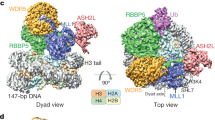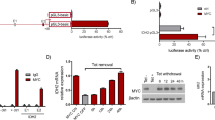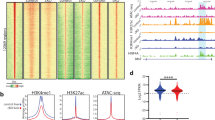Abstract
The post-translational modifications of histone tails generate a ‘histone code’ that defines local and global chromatin states1. The resultant regulation of gene function is thought to govern cell fate, proliferation and differentiation2. Reversible histone modifications such as methylation are under mutual controls to organize chromosomal events3,4. Among the histone modifications, methylation of specific lysine and arginine residues seems to be critical for chromatin configuration and control of gene expression5. Methylation of histone H3 lysine 4 (H3K4) changes chromatin into a transcriptionally active state6. Reversible modification of proteins by β-N-acetylglucosamine (O-GlcNAc) in response to serum glucose levels regulates diverse cellular processes7,8,9. However, the epigenetic impact of protein GlcNAcylation is unknown. Here we report that nuclear GlcNAcylation of a histone lysine methyltransferase (HKMT), MLL5, by O-GlcNAc transferase facilitates retinoic-acid-induced granulopoiesis in human HL60 promyelocytes through methylation of H3K4. MLL5 is biochemically identified in a GlcNAcylation-dependent multi-subunit complex associating with nuclear retinoic acid receptor RARα (also known as RARA), serving as a mono- and di-methyl transferase to H3K4. GlcNAcylation at Thr 440 in the MLL5 SET domain evokes its H3K4 HKMT activity and co-activates RARα in target gene promoters. Increased nuclear GlcNAcylation by means of O-GlcNAc transferase potentiates retinoic-acid-induced HL60 granulopoiesis and restores the retinoic acid response in the retinoic-acid-resistant HL60-R2 cell line. Thus, nuclear MLL5 GlcNAcylation triggers cell lineage determination of HL60 through activation of its HKMT activity.
This is a preview of subscription content, access via your institution
Access options
Subscribe to this journal
Receive 51 print issues and online access
$199.00 per year
only $3.90 per issue
Buy this article
- Purchase on Springer Link
- Instant access to full article PDF
Prices may be subject to local taxes which are calculated during checkout




Similar content being viewed by others
References
Strahl, B. D. & Allis, C. D. The language of covalent histone modifications. Nature 403, 41–45 (2000)
Bernstein, B. E., Meissner, A. & Lander, E. S. The mammalian epigenome. Cell 128, 669–681 (2007)
Sarma, K. & Reinberg, D. Histone variants meet their match. Nature Rev. Mol. Cell Biol. 6, 139–149 (2005)
Li, B., Carey, M. & Workman, J. L. The role of chromatin during transcription. Cell 128, 707–719 (2007)
Zhang, Y. & Reinberg, D. Transcription regulation by histone methylation: interplay between different covalent modifications of the core histone tails. Genes Dev. 15, 2343–2360 (2001)
Mikkelsen, T. S. et al. Genome-wide maps of chromatin state in pluripotent and lineage-committed cells. Nature 448, 553–560 (2007)
Hart, G. W., Housley, M. P. & Slawson, C. Cycling of O-linked β-N-acetylglucosamine on nucleocytoplasmic proteins. Nature 446, 1017–1022 (2007)
Jackson, S. P. & Tjian, R. O-glycosylation of eukaryotic transcription factors: implications for mechanisms of transcriptional regulation. Cell 55, 125–133 (1988)
Kelly, W. G. & Hart, G. W. Glycosylation of chromosomal proteins: localization of O-linked N-acetylglucosamine in Drosophila chromatin. Cell 57, 243–251 (1989)
Chambon, P. A decade of molecular biology of retinoic acid receptors. FASEB J. 10, 940–954 (1996)
Collins, S. J. The role of retinoids and retinoic acid receptors in normal hematopoiesis. Leukemia 16, 1896–1905 (2002)
Nakamura, T. et al. ALL-1 is a histone methyltransferase that assembles a supercomplex of proteins involved in transcriptional regulation. Mol. Cell 10, 1119–1128 (2002)
Dou, Y. et al. Physical association and coordinate function of the H3 K4 methyltransferase MLL1 and the H4 K16 acetyltransferase MOF. Cell 121, 873–885 (2005)
Emerling, B. M. et al. MLL5, a homolog of Drosophila trithorax located within a segment of chromosome band 7q22 implicated in myeloid leukemia. Oncogene 21, 4849–4854 (2002)
Hughes, C. M. et al. Menin associates with a trithorax family histone methyltransferase complex and with the hoxc8 locus. Mol. Cell 13, 587–597 (2004)
Lee, M. G. et al. Demethylation of H3K27 regulates polycomb recruitment and H2A ubiquitination. Science 318, 447–450 (2007)
Cho, Y. W. et al. PTIP associates with MLL3- and MLL4-containing histone H3 lysine 4 methyltransferase complex. J. Biol. Chem. 282, 20395–20406 (2007)
Mori, J. et al. Characterization of two novel retinoic acid-resistant cell lines derived from HL-60 cells following long-term culture with all-trans-retinoic acid. Jpn. J. Cancer Res. 90, 660–668 (1999)
Wysocka, J. et al. Human Sin3 deacetylase and trithorax-related Set1/Ash2 histone H3–K4 methyltransferase are tethered together selectively by the cell-proliferation factor HCF-1. Genes Dev. 17, 896–911 (2003)
Si, J., Mueller, L. & Collins, S. J. CaMKII regulates retinoic acid receptor transcriptional activity and the differentiation of myeloid leukemia cells. J. Clin. Invest. 117, 1412–1421 (2007)
Yang, X. et al. Phosphoinositide signalling links O-GlcNAc transferase to insulin resistance. Nature 451, 964–969 (2008)
Dentin, R. et al. Hepatic glucose sensing via the CREB coactivator CRTC2. Science 319, 1402–1405 (2008)
Kitagawa, H. et al. The chromatin-remodeling complex WINAC targets a nuclear receptor to promoters and is impaired in Williams syndrome. Cell 113, 905–917 (2003)
Ohtake, F. et al. Dioxin receptor is a ligand-dependent E3 ubiquitin ligase. Nature 446, 562–566 (2007)
Takada, I. et al. A histone lysine methyltransferase activated by non-canonical Wnt signalling suppresses PPAR-gamma transactivation. Nature Cell Biol. 9, 1273–1285 (2007)
Fujiki, R. et al. Ligand-induced transrepression by VDR through association of WSTF with acetylated histones. EMBO J. 24, 3881–3894 (2005)
Wells, L. et al. O-GlcNAc transferase is in a functional complex with protein phosphatase 1 catalytic subunits. J. Biol. Chem. 279, 38466–38470 (2004)
Acknowledgements
We thank A. Miyajima and S. Saito for cell lines, P. Chambon, T. Kitamura and S. Suzuki for experimental materials, H. Akaishi for technical support, and M. Yamaki for manuscript preparation. This work was supported in part by priority areas from the Ministry of Education, Culture, Sports, Science and Technology (to H.K. and S.K.).
Author Contributions S.K. planned the project and analysed the experiments together with R.F., R.G.R. and H.K. R.F., T.C., W.H., H.I. and I.T. conducted the experiments. The manuscript was written by S.K. and R.F., and all authors commented on it.
Author information
Authors and Affiliations
Corresponding author
Supplementary information
Supplementary Information
This file contains a Supplementary Table and Supplementary Figures S1-S31 with Legends. (PDF 2858 kb)
Rights and permissions
About this article
Cite this article
Fujiki, R., Chikanishi, T., Hashiba, W. et al. GlcNAcylation of a histone methyltransferase in retinoic-acid-induced granulopoiesis. Nature 459, 455–459 (2009). https://doi.org/10.1038/nature07954
Received:
Accepted:
Published:
Issue Date:
DOI: https://doi.org/10.1038/nature07954
This article is cited by
-
Phthalates impact on the epigenetic factors contributed specifically by the father at fertilization
Epigenetics & Chromatin (2023)
-
O-GlcNAcylation: the sweet side of epigenetics
Epigenetics & Chromatin (2023)
-
SETD5 regulates the OGT-catalyzed O-GlcNAcylation of RNA polymerase II, which is involved in the stemness of colorectal cancer cells
Scientific Reports (2023)
-
O-GlcNAcylation: A Crucial Regulator in Cancer-Associated Biological Events
Cell Biochemistry and Biophysics (2023)
-
Autism Spectrum Disorders in Offspring Exposed to Maternal Gestational Diabetes: a Meta-Analysis and Systematic Review
Review Journal of Autism and Developmental Disorders (2023)
Comments
By submitting a comment you agree to abide by our Terms and Community Guidelines. If you find something abusive or that does not comply with our terms or guidelines please flag it as inappropriate.



